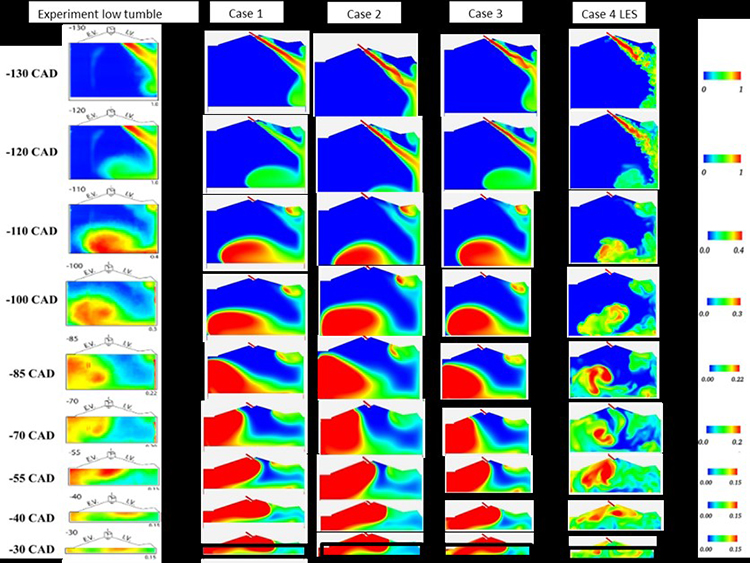Background
Decarbonizing transportation remains a paramount challenge, especially for medium-to-heavy-duty applications like long-haul trucks where battery-electric solutions might fall short. Hydrogen fuel cells emerge as a potential solution, but their high costs and durability concerns are pushing manufacturers toward hydrogen-fueled internal combustion engines. Hydrogen's unique properties, such as its low motor octane rating and different mixing characteristics, pose challenges, however. Direct injection (DI) is seen as a requisite for achieving optimal efficiency and power density, but the industry's experience with Computational Fluid Dynamics (CFD) tools for hydrogen engines is limited. Despite attempts to model hydrogen direct injection, discrepancies persist between simulations and experimental data, raising questions about the precision of CFD tools in predicting hydrogen combustion.
The primary objective of this project was to assess the capability of existing CFD tools in designing direct injection hydrogen combustion systems. The project aimed to discern the impact of variables like mesh size on simulation accuracy, evaluate the potential of Large Eddy Simulation (LES) in enhancing mixing predictions, and ascertain the need for further CFD tool development for future engine designs. Experimental optical spray penetration and mixing data from Sandia optical hydrogen engine were used to compare against CFD results for hydrogen injection and mixing. Later, combustion experimental data from a SwRI 1.3 liter, direct injected single-cylinder hydrogen engine were used to evaluate CFD predictions of mixing and combustion.
Approach
Using the Converge CFD software, simulations were conducted to understand the effects of direct hydrogen injection in engines. Initially, the study compared the software's predictions with experimental results from the Sandia optical DI-H2 engine, specifically focusing on hydrogen dispersion influenced by turbulence modeling. Subsequently, a more detailed simulation, including combustion process, was performed based on a single-cylinder engine used at SwRI. This simulation incorporated flow dynamics within the hydrogen injector and utilized CT scan data to capture the injector's internal geometry, ensuring accurate spray momentum predictions.
Accomplishments
Initial simulations aimed to replicate experimental hydrogen mole fraction results from the Sandia DI-H2 engine at various times post hydrogen injection. These simulations employed both the Re-Normalization Group (RNG) k-ε turbulence model and the Large Eddy Simulation (LES) turbulence model. The LES model, despite its higher computational demands, provided more accurate predictions of turbulent mixing and combustion, when compared to experimental data. However, the RANS model, commonly used for other fuels, was not sufficient for hydrogen's unique injection and mixing characteristics.
In the subsequent phase, which centered on the SwRI DI-H2 single-cylinder engine, challenges arose due to the extremely small injector hole size, necessitating a short simulation time step to maintain the Courant-Friedrichs-Lewy (CFL) value at 1. Using a CFL value of 1 resulted in a very long simulation time of about one day per degree of crank angle, making it impractical. The combustion simulation was conducted using a higher CFL value of 5 which compromised the simulation's accuracy, leading to discrepancies in fuel distribution and a failure of ignition in the model, in contrast to the experiment. This highlighted the limitations of current CFD tools in guiding the design of DI hydrogen combustion systems, especially with small injector hole sizes.
In conclusion, the project underscored the need for more advanced simulation tools for hydrogen combustion system development. The findings were shared with the HEDGE-V consortium and feedback indicates a strong industry interest in refining CFD simulation for hydrogen combustion system design. Plans are underway to explore potential solutions by proposing a regular internal research program on improving hydrogen mixing models in CFD, with the aim of bolstering SwRI's capabilities in assisting clients with hydrogen combustion system designs driven by CFD.

Figure 1: Comparisons of H2 Mole Fraction from CFD against PLIF Optical Data.
